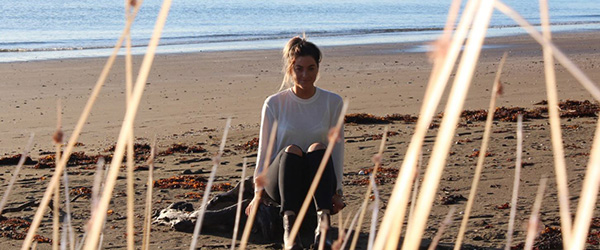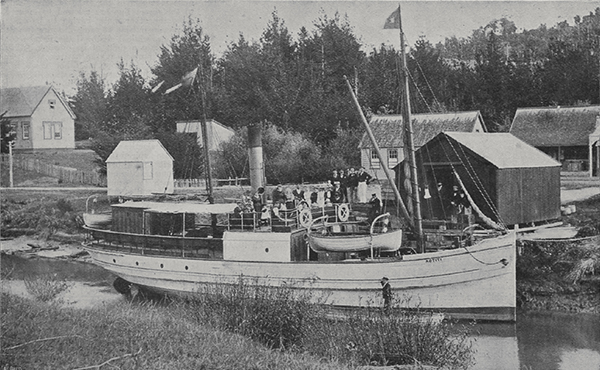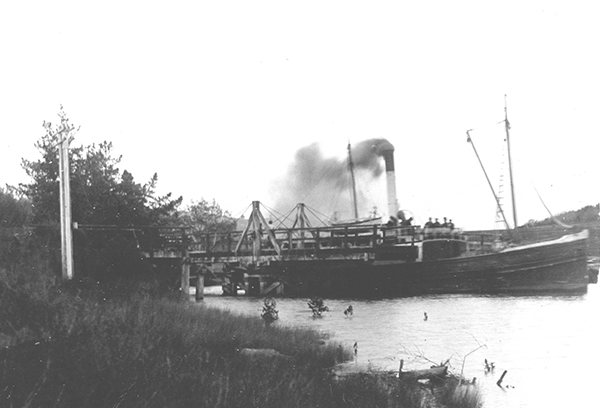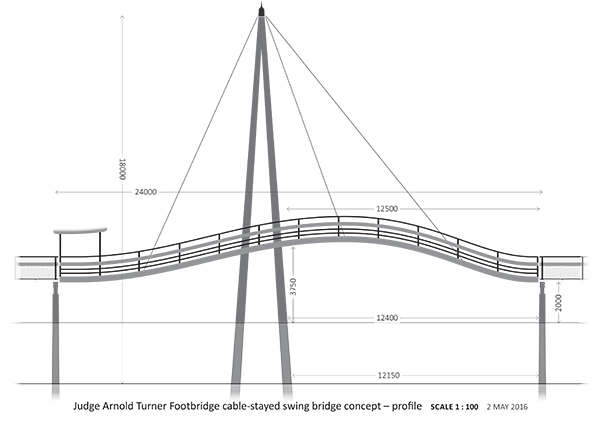Garnering major help to connect this coast


Face of Connect this Coast: While there are innumerable forms that the proposed Judge Arnold Turner Footbridge could take, and places it could be located between the river mouth and the three-kilometre farthest point upstream that is accessible to the public, there is no debate at all as to which of the trustees should be the face of the project. Tessa Berger in the May 2016 Junction Magazine double-page spread. photographer Caitlin Owston-Doyle
You read it there first, in a full-page spread in Junction Magazine, profiling ‘uber-human’ Tessa Berger, the 21-year-old chair of the Mahurangi Coastal Trail Trust.
Anyone reading the glossy Matakana-based magazine’s description of Tessa’s achievements to date, including American President’s List scholar, and her current workload with her business start-up, The Merchandise Collective, and not mentioned, her work with Auckland Council toward reducing sediment generated on Warkworth building sites, might wonder where she would find the hours in the day to front fundraising for the Mahurangi Coastal Trail.
But if there was one thing that Adam Gard’ner and Duane Major were adamant about, it was that Tessa must be the face of any crowdsourcing fundraiser, and they came to this opinion on their Christchurch–Auckland flight to speak at the annual Fundraising Institute of New Zealand conference, even before meeting Tessa face to face.
Met by Bill Burrill at the airport, Adam and Duane immediately devoted more than two hours exclusively to discussing Mahurangi Coastal Trail crowdsourcing strategies and tactics with trustees. Ever since the immensely popular, sometimes controversial, but ultimately successful bid to raise more than $2 million to do what Stuff promoted as ‘Buy this beach,’ crowdsourcing had become the obvious route for the trust to take.

End of an Era: The sixty-year steamboat era of the Mahurangi came to an abrupt end for the Pūhoi village a decade earlier in 1924 when a significant flood washed the highway swing bridge away. With the, by then, increasing reliance on road transport, the pivoting bridge was able to be replaced with a fixed span, ending service from the likes of the Kotiti, here pictured alongside the Pūhoi Wharf, 1899. image Pūhoi Museum
From Tessa’s first contact, Adam and Duane could not have been more responsive, finding everything to support in the Mahurangi Coastal Trail concept, which, in common with their campaign, was less about one beach, in their case Awaroa, and more about New Zealanders’ right to traverse the coastline, enjoying all the beaches along the way. Consequently, quite some time was spent brainstorming options for a title for the fundraising campaign. ‘Save this beach’ might have appeared to be the obvious salute to Fairfax’s media savvy catchcry, but, as Adam and Duane so passionately advocated, the campaign should be stringently positive, despite that, for many, it is about saving Te Muri, from being blighted by road access and a car park. In the subsequent process of interpreting the copious notes that Bronwen Turner took during the strategising, ‘Connect this coast’ was distilled, and is being used, at least in the build-up to the fundraising.
What wasn’t anticipated by any of the coastal trail trustees was an admonishment, by the life partner of one who happened to be sitting in, that the footbridge central to the campaign must be a thing of beauty. This, it was argued, for many people considering supporting the project, would be pivotal, given the pristine state of the estuarine environment into which the footbridge was being imposed. This bombshell shocked the trustees into facing an inconvenient truth about the project. To many, the visual landscape of the Wenderholm Regional Park, but all such parks, is sacrosanct, and must not be despoiled by any structure that, regardless of its public good. And it transpired that this was a misgiving the trustees felt about the extant, utilitarian design. The answer, of course, was to seek professional help to design an ‘elegant’ footbridge. On the recommendation of nationally respected landscape architect Jan Woodhouse, who had already written a draft landscape visual assessment for the footbridge, Mike Farrow of Littoralis Landscape Architecture has been retained, confirmed as of yesterday. Mike has a rare reputation for landscape architecture that is both sympathetic and buildable, and was consulted by Alan Mayne and Mike Owston-Doyle on the Mahurangi West Hall restoration, nearly a decade before work got underway there in earnest. More recently, in 2003, Mike produced a comprehensive landscape plan for the Mahurangi West Road, paid for, and consequently ignored by, Rodney District Council.

Antediluvian Swing Bridge: Before ‘the great flood’ of 1924, the bridge three iterations before the current State Highway 1 structure in that location could be swung open, as in this image of the Kotiti steaming downstream through the opening, to allow access to the township of Pūhoi. The hastily build replacement, sadly, was non-opening, and with water transport was still important, a wharf was built farther downstream, close to the lay-by that served the since-removed toll-road payment kiosk. image Pūhoi Museum
Until the timely intervention, devising the cheapest possible way to the cross the Pūhoi Estuary had been the engineering objective, with the estimated cost currently being $1 million, up from a 2012 estimate of $600 000. But at two separate meetings with Auckland Council, officers had stressed that there was a statutory requirement for the project to pass a stringent landscape impact threshold, given that the Pūhoi Estuary landscape is afforded the highest visual protection zone available. And this is exactly as it should be, irrespective of the virtues or otherwise of resource management law and practice. In anticipation of the hearings on the Auckland Regional Parks management plan variation in respect to Te Muri, which are now not expected to be held before late JuneAnnette Campion (personal communication, 3 May 2016), a visualisation of an elegant Judge Arnold Turner Footbridge option is being developed. It will cost substantially more than the utilitarian alternative, but unless the footbridge proposed can begin to pass muster visually, its cheapness or otherwise is academic.
Besides, for ‘uber-human’ Tessa Berger to convincingly front the Connect this Coast campaign, she must passionately believe in every aspect of the project, particularly in the execution of the lengthy footbridge required to cross the Pūhoi, the river of her forbears. Until the belated arrival of all-weather roads—the highway between Auckland and Warkworth wasn’t metalled until 1933, and only then thanks to public works during the Great Depression—the river was an essential link between the Pūhoi community and the outside world. So when the precursor to the current State Highway 1 needed to cross the Pūhoi River, a bridge with an opening span was built, allowing steamboats, on the tide, to continue to reach the township. The form the opening span took was a swing bridge, but not the simple suspension footbridge to which New Zealanders colloquially refer as a swing bridge—from the readiness of such constructions to sway from side to side as a walker’s weight transfers from one leg to another. Actual swing bridges—the alternate name pivot bridge describes their operation much better—typically balance on turntable atop a pier, and ‘swing’, or pivot through 90° to allow vessels to pass. Aucklanders holidaying on the Coromandel Peninsula, until it was superseded in 2011, were all-too familiar with the Kopu swing bridge, but not because it pivoted, which it rarely did post the steamboat era, but because, being long and single-laned, but because of lengthy, long-weekend queues it caused.

Unique Cable-Stayed Swing Bridge: While the concept of a cable-stayed swing bridge is not unique—the one that crossed the Pūhoi River until 1924 was one such structure—the concept sketched here might be unique in that the supporting piers continue up through a stationary circular section of deck to form the masthead for the cable stays. This allows for the swing (pivot) bridge to be much lighter physically and visually than the rather squat example that served Pūhoi. As long as both deck spans form part of a bridge’s deck, the swing bridge form is more efficient than any other form of opening span, be it lifting or sliding. The fact that, in the case of both the old Pūhoi swing bridge and the one proposed for the Mahurangi Coastal Trail, the second opening is not particularly navigationally useful, is of no consequence. concept sketch Mahurangi Magazine
All opening spans have their pros and cons, but the elegance of the swing bridge, conceptually, is that the span, in order to be opened, is not required to be lifted, but is simply rotated. And while it is common to use a counterbalance to aid the raising of a lifting span, that weight comes at the cost of additional piling needed to support it. When Craig Davis, who’d until recently had been Rodney District Council’s coastal engineer, produced a preliminary Mahurangi Coastal Trail route and footbridge profile, in 2012, he suggested that the Pūhoi swing bridge set a useful historic precedent, and a powerful attribute to cite at the resource application stage. Indeed, it may yet prove to be the margin the gets the project over the resource-consent line, and the fundraising underway.
It had earlier been planned to launch the fundraising with a celebrity event, held in time to demonstrate the depth of public support for the coastal trail to those considering the management plan variation in respect to Te Muri. But now, with crowdsourcing having been determined the obvious strategy, it is necessary that, at the completion of the Givealittle campaign, those who have pledged get to know whether the target has been reached and, if so, that funds will leave their accounts. Leaving that uncertainty hanging over folk for the six months or more that it might take to secure the resource consent, would be an all-too-unreasonable an imposition on supporters’ generosity—effectively a show-stopper.
Once home again in Christchurch, Adam Gard’ner and Duane Major wasted no time in giving the Mahurangi Coastal Trail a shout-out from Facebook. This, ultimately, is how they see themselves best able to help, and having inspired a total of 39 249 pledges—by people the vast majority of whom will never actually access Te Awaroa Beach—they are uniquely placed to commend Connect this Coast, or as they put it:
Go them
